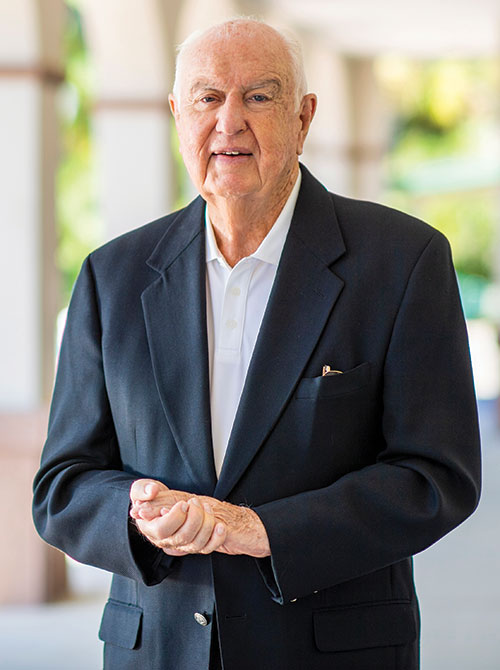
Distance education took root in the institutional culture before FGCU even had a physical campus or welcomed its first class of students in 1997 – though no one could have foreseen then the necessity of one day closing classrooms, temporarily teaching and learning 100 percent online and celebrating commencement in a virtual setting.
In the beginning, part of FGCU’s mission was to serve not only traditional age college students but to bring higher education to community members who couldn’t come to campus because of jobs, family life or other considerations. Distance education was one aspect among several that made the university unique: a commitment to service-learning; in lieu of tenure, renewable faculty contracts and the flexibility to work elsewhere; a focus on sustainability in operations and in curriculum.
The man behind the mission, founding president Roy McTarnaghan, had done his homework well before drawing up institutional plans and guiding principles for FGCU. Since his first administrative position at the State University of New York-Geneseo in the early 1960s, if not earlier, he persistently explored ways to run educational systems more effectively and efficiently, and to measure their success, with the analytical aptitude of an engineer.
Decades of professional service at local, state and regional levels in higher education and research into institutional models around the world informed McTarnaghan’s priorities. He saw what worked and what didn’t. Then he brought the best ideas and proven leaders together at FGCU, one of five colleges or universities McTarnaghan helped get off the ground in the course of his long career. “As a new institution we could propose doing some things other places were not doing – we were not locked into doing things a certain way,” says McTarnaghan, who served as president from 1993 until 1999 and continues to take an active role in university events and build on his philanthropic legacy (see accompanying story).
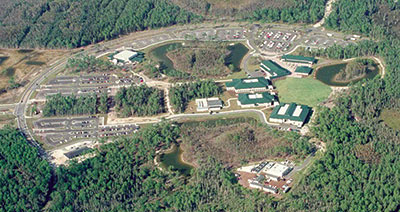
“I made sure our Board of Regents and the Florida Legislature endorsed this mission because it was different from what other people were doing. All the individual elements existed somewhere in the world. I can proudly point to places where they are working. It was all done with clear intent to solidify the structure of what we were going to do initially to get up and running, and to know our goals and how to measure their effectiveness when we got there.”
“Visionary” is a word many choose when talking about McTarnaghan, including Wilson G. Bradshaw, FGCU’s president from 2007 to 2017. He says, “Roy knows education and the higher education system inside and out.”
“He saw that online distance education was going to be the wave of future. While we did not get there by embracing it altogether, we got there by necessity,” says Bradshaw, FGCU’s third president, referring to COVID-19’s reprioritizing of remote instruction. “What we were doing then wasn’t happening anywhere else in the country in higher ed, and Roy left a solid foundation at FGCU. But he also had an impact on the entire State University System for many years.”
As vice chancellor for academic affairs for that system since 1975, McTarnaghan was already poised to a play a major role when discussion began in the late 1980s about developing what would become a new university serving Southwest Florida. By the time he was put in charge of planning FGCU, he’d already amassed close to three decades in higher education administration.
The impact Roy McTarnaghan had, and continues to have, on FGCU transcends any simple accounting. Roy, along with his wife, Beverly, began shaping this university from day one. His relentless commitment to serving students and the community is part of FGCU’s DNA. Roy has remained engaged in supporting FGCU’s ongoing journey to excellence and service. On a personal level I’ve come to value Roy as a friend, a colleague and a wise counselor.
— FGCU President Mike Martin
As a member of the Florida Board of Regents, which governed state universities at that time, longtime educator and administrator Audrea Anderson of Fort Myers helped select McTarnaghan as FGCU’s founding president. She then worked with him throughout the 1990s as they sought input and buy-in from a sprawling, diverse field of stakeholders. “Roy McTarnaghan’s vision for Florida’s 10th university paralleled the critical needs of our region,” says Anderson, who served as FGCU’s associate vice president for Community Relations and Marketing from 2000 to 2009. “I recall his emphasis on establishing a premier academic institution that aggressively supports the region’s most critical resource, the environment. McTarnaghan’s passion for responsibly caring for the environment was always evident. He worked tirelessly to build resources – faculty talent, funding, facilities, internal and external support – to ensure the university’s lead position in protecting and preserving Southwest Florida’s natural resources while enjoying its benefits and beauty.”
Roy McTarnaghan was an exceptional founding president. He brought such character and heart to the university, and I think that is his greatest legacy. Roy’s integrity and his passion inspired the community. He was very inclusive, and treated everyone around him with decency and respect. In short, he was a great leader and FGCU would certainly not be what it is today without his contributions. Our community and past, present and future students owe him a debt of gratitude.”
— Amy Gravina, APR, founder of Gravina, Smith, Matte & Arnold Marketing and Public Relations, who worked with McTarnaghan to establish what became the annual Founder’s Cup fundraising golf tournament.
Early experiences influence mission
McTarnaghan was FGCU Employee No.1.
His first hire, Employee No. 2, was Executive Assistant Barbara Krell, who served as the gatekeeper for six FGCU presidents – including three interims – before retiring in 2015. She had a frontrow seat to the birth of the new university and many of its growing pains.
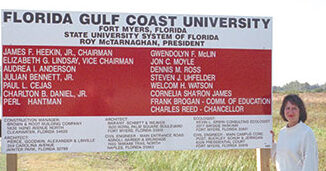
Krell and others still marvel at how focused McTarnaghan remained through four years of organizational planning and execution. Through site selection, construction challenges, environmental litigation. Through curriculum development and the race for accreditation. Through fundraising and myriad other challenges. McTarnaghan chronicled the success story of opening the doors on schedule in August 1997 in his book, “On Task, On Time: The Development of Florida Gulf Coast University.”
“He was the person for the time,” Krell says. “It’s more clear to me now than ever how important his understanding of the political background was, how to accomplish educational goals within that political arena, and the absolute attention to all details. Not everyone has all of those things. And he had understanding of what it means to be a student.”
Three months after hiring Krell, McTarnaghan brought Susan Evans on board as a public information/public relations officer. Her role expanded into chief of staff and vice president while serving each successive president over 27 years until this March. Looking back at McTarnaghan’s leadership, Evans zeroes in on the positive ripple effect of signature FGCU programs like service-learning on generations of students and individuals and organizations in the community: 3 million hours of service in nearly 25 years.
“We opened with some unique features,” Evans recalls. “Dr. McTarnaghan was able, after a long career in higher education, to take meaningful yet novel ideas and bring them into the fabric of this university.
Think of all the entities that have had the benefit of our students contributing time and service to them – what a value that has as a community. That was his idea.”

The commitment to public service stems from a patchwork of personal experiences stitched together over McTarnaghan’s 87 years, including his stint in the U.S. Army during the early 1950s. Later, he earned degrees at two land-grant institutions – a master’s in speech education from The Ohio State University and a Ph.D. in educational administration from Michigan State University – that had strong cooperative extension service programs helping farmers and others in their communities. And in the mid-1980s, through his responsibilities and travels for the Florida State University System, McTarnaghan discovered a service-learning program at the University of Costa Rica that would one day provide inspiration for FGCU’s program.
“It made students at the university there more aware of the surrounding area and what they can and should do to build a better society,” he recalls. “I think service to one’s country and service to one’s community tends to bring people together from various backgrounds and economic strata for a common goal. As part of a mission plan for a university it would be a very positive psychological and philosophical benefit.”
‘Always about the students’
Likewise, McTarnaghan’s enthusiasm for technology and distance learning harks back to early life experiences. Education was a high priority in his family. He was one of few in his high school class who had a grandparent who graduated college, he says.
It was his high school physics class, though, that set him on course toward distance learning. Noticing that the teacher, fresh out of military service, was barely ahead of his students in understanding the subject, the collegebound McTarnaghan found another way to keep his own learning on track: early-morning “Sunrise Semester” courses offered by New York University via the relatively new technology of television. Students could get textbooks by mail, watch lectures at home before school or work, and take exams in secure locations. By the time he sat for the New York State Board of Regents’ college entrance exams, he “pretty well aced the physics exam,” he says.
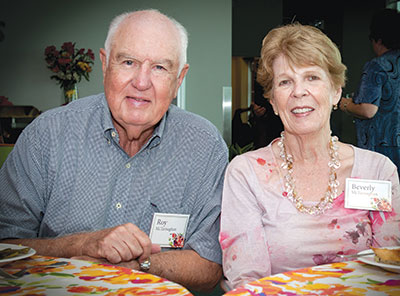
“I had a need and was motivated and could learn without being in the classroom setting,” says McTarnaghan, who would build on this insight by visiting and studying pioneering distance-learning models across the world. From Athabasca University in Northern Alberta to the University of Southern Queensland in Australia to The Open University in the United Kingdom, he learned from the successes and failures of leading online universities.
Those lessons helped shaped his approach when developing plans for FGCU to meet not just campus needs but community needs. He talked about aiming for 25 percent of classes to be offered remotely – a far cry from what 2020 would eventually call for – and early on worked with the FGCU Foundation to set aside money to encourage faculty to develop online courses. “It was always about the students,” Evans says. “For him it was a way to provide access to higher education that these folks would not have had without distance learning.”
Surprising the skeptics
Some of FGCU’s unconventional approaches met with skepticism. McTarnaghan says he and other leaders had to sell some prospective faculty and
staff on not only distance learning but weekend classes and renewable contracts. They explained the sustainability ethos. They talked up the option of cooperative employment arrangements with area school districts.
It was a lot. And it wasn’t for everyone. “Other institutions wanted nothing to do with us,” McTarnaghan says of sister schools around the state. “They went to the legislature and said this institution will fail, it will never get accredited, nobody in their right mind would go to work there with these themes. Well, we had 20,000 faculty applications for our first 150 positions, and we were accredited in record time.”
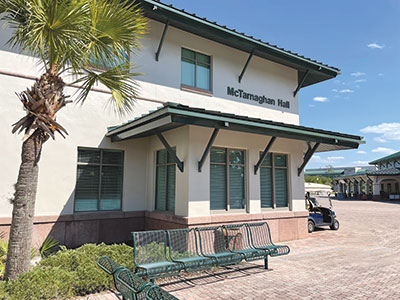
He credits much of that success to hiring experienced leaders with proven track records, not just academic credentials. Senior staff had to be people who had “been there, done that,” in his own words.
“He was and is a visionary but not a
micromanager,” says founding faculty member Win Everham, a professor in the Department of Ecology & Environmental Studies. “He hired the best people he could and trusted them to do the right thing, to hire the people with the skill sets.”
When FGCU’s buildings started rising from former rock mining pits and next to pockets of wetlands and uplands, the construction management team met Fridays on Roy and Beverly McTarnaghan’s lanai in Pelican Landing. The couple had chosen the Bonita Springs community intentionally – halfway between Fort Myers and Naples to show that FGCU would be serving as well as fundraising in both.
Those sessions were intended to resolve by day’s end any issue that arose in the previous week – without the formality of a drawn-out committee meeting. McTarnaghan calls it the J.C. Penney approach: “We’d have a vote. ‘All in favor say aye. All opposed say I quit.’ It was a joke, but we had to make up a lot of time and were going to have to make tough decisions as a small group of people.”
Some decisions were easier than others. The school colors of emerald green and cobalt blue were chosen to represent earth and water and FGCU’s commitment to environmental and sustainability education.
“My wife and I were pushing for that to reflect the mission,” McTarnaghan says. “No one seemed to object. There’s a lot you can do when you don’t have large committees.”
FGCU’s mascot was actually in his back pocket for years, a tucked away trump card saved over decades of service in the State University System.
“It surprised me to no end that no one had chosen the eagle, the American mascot, as the emblem for their college or university,” he says. “We’ve got the burrowing owl at FAU, the rattler at FAMU, but we didn’t have the eagle. Always in the back of my mind, I had the idea if I had the chance at a new institution, I’m going to really try to have the American eagle as a mascot.”
Another mission accomplished.[/vc_column_text][vc_column_text]
McTARNAGHAN LEGACY SOCIETY HONORS FOUNDING PRESIDENT
The FGCU Foundation’s Legacy Society was established in 2005 to recognize donors who have included Florida Gulf Coast University in their estate plans. These forward-thinkers help ensure that the university sustains its commitment to academic excellence and student success for generations to come.
The man who put this institution on that path — and who led creation of the FGCU Foundation to support that mission — is Roy McTarnaghan. To pay tribute to the founding president and his philanthropic support over two-plus decades, the Legacy Society was recently rechristened the Dr. Roy McTarnaghan Legacy Society.
“We started talking to him about this five or six years ago, as a way to honor the gentleman who started this university and continues to support it through his scholarship endowed fund and now through planned giving,” says Bill Rice, senior associate vice president in University Advancement. “What could be more appropriate than recognizing our first president in perpetuity through the naming of our Legacy Society?”
McTarnaghan and his wife of 65 years, Beverly, have remained active in FGCU’s campus life and philanthropy since he stepped down in 1999. They especially enjoy the foundation’s annual scholarship luncheon.
“We are very happy to support student scholarships. When our scholarship students say thank you, I always tell them the way to thank us is that when you get to be 65 you give some of your money to help someone else with a scholarship,” McTarnaghan says. “One of the reasons FGCU was established here was that this area had the lowest college-going rate in the entire state. A lot of people couldn’t get higher education unless a new institution came to them.”
Membership in the Dr. Roy McTarnaghan Legacy Society is open to anyone who has made a gift of any amount through an estate plan, or through a life income arrangement or life insurance policy. Benefits include a subscription to this magazine and the Planned Giving e-Newsletter, an engraved memento and invitations to special events.